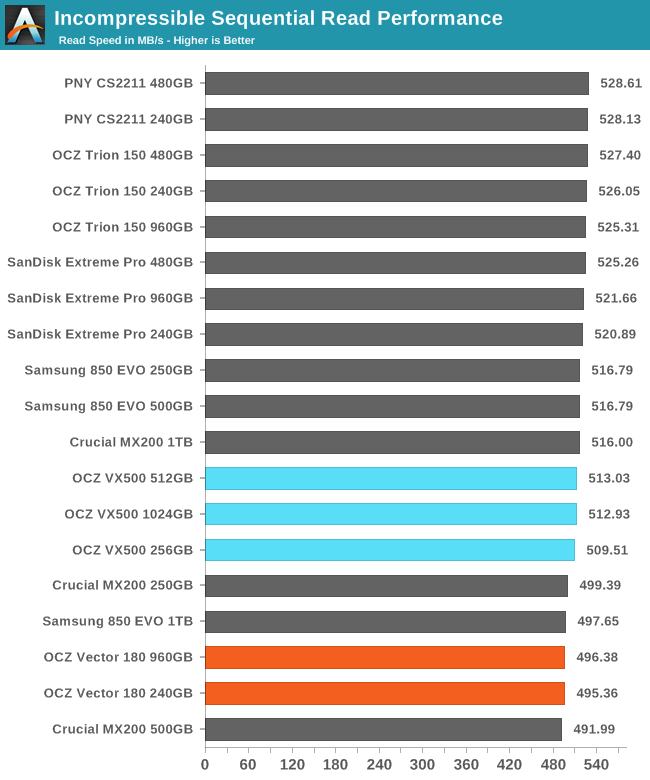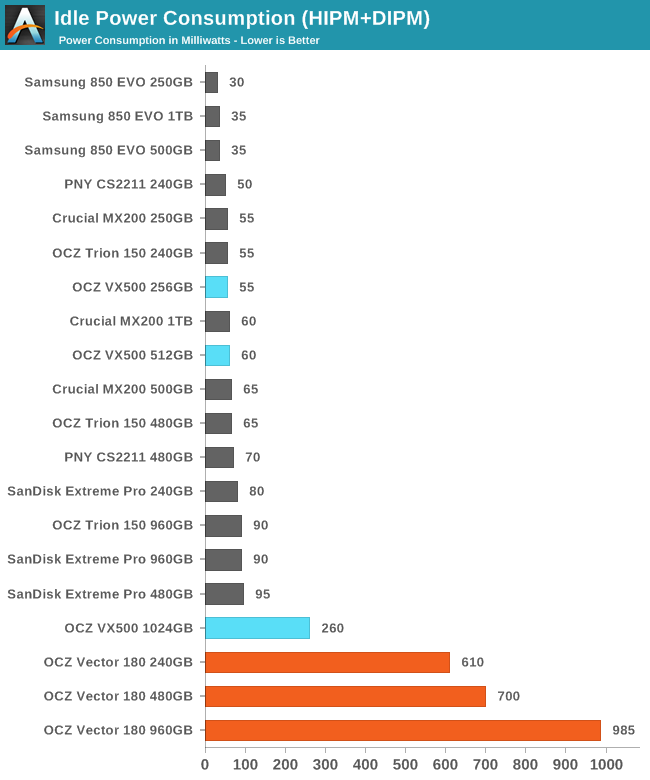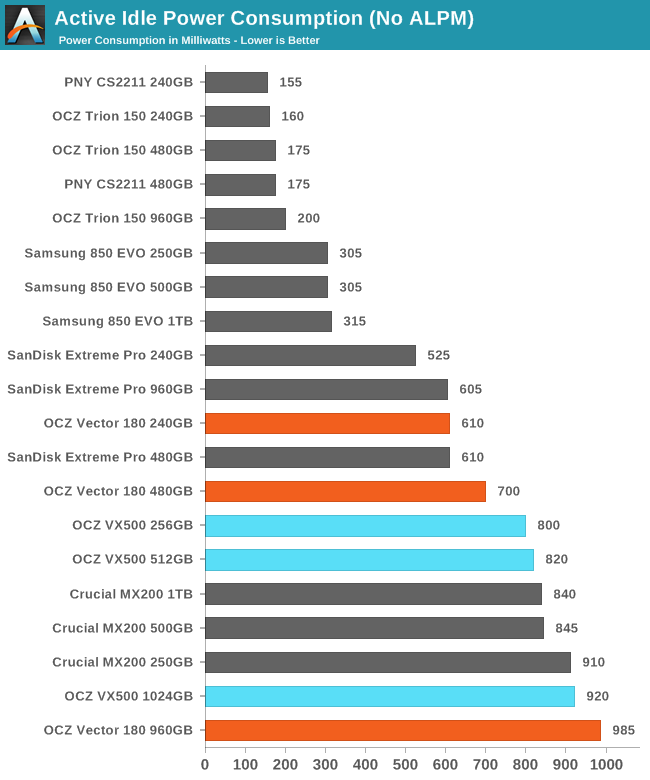The Toshiba OCZ VX500 (256GB, 512GB, 1024GB) SSD Review
by Billy Tallis on September 13, 2016 9:00 AM ESTATTO
ATTO's Disk Benchmark is a quick and easy freeware tool to measure drive performance across various transfer sizes.
 |
|||||||||
At small transfer sizes, the OCZ VX500 has better read speed but worse write speed than the Vector 180. Unlike the Vector 180, the VX500 maintains steady performance through the second half of the test with solid read and write speeds.
AS-SSD
AS-SSD is another quick and free benchmark tool. It uses incompressible data for all of its tests, making it an easy way to keep an eye on which drives are relying on transparent data compression. The short duration of the test makes it a decent indicator of peak drive performance.


Peak read speeds for the VX500 are good and a slight but ultimately meaningless improvement over the Vector 180. Peak sequential write speeds are confirmed to be fine despite the poor showing on the more intense IOmeter test.
Idle Power Consumption
Since the ATSB tests based on real-world usage cut idle times short to 25ms, their power consumption scores paint an inaccurate picture of the relative suitability of drives for mobile use. During real-world client use, a solid state drive will spend far more time idle than actively processing commands. Our testbed doesn't support the deepest DevSlp power saving mode that SATA drives can implement, but we can measure the power usage in the intermediate slumber state where both the host and device ends of the SATA link enter a low-power state and the drive is free to engage its internal power savings measures.
We also report the drive's idle power consumption while the SATA link is active and not in any power saving state. Drives are required to be able to wake from the slumber state in under 10 milliseconds, but that still leaves plenty of room for them to add latency to a burst of I/O. Because of this, many desktops default to either not using SATA Aggressive Link Power Management (ALPM) at all or to only enable it partially without making use of the device-initiated power management (DIPM) capability. Additionally, SATA Hot-Swap is incompatible with the use of DIPM, so our SSD testbed usually has DIPM turned off during performance testing.

With no SATA ALPM support from the Barefoot 3 controller, the Vector 180 distorts the scale of the slumber power graph. The smaller capacities of the VX500 are fine, but the 1TB is using an extra 200mW, most likely because the external DRAM interface is remaining active.

Active idle power consumption is not great and only the 1TB manages to be an improvement over the Vector 180, but most mobile systems make proper use of the slumber state and are thus unaffected by this.










29 Comments
View All Comments
Chaitanya - Tuesday, September 13, 2016 - link
How is the after sales service of these drives since Toshiba take over? I have heard some horror stories of RMA with OCZ in past.JebSpringfield - Tuesday, September 13, 2016 - link
I bought one OCZ drive a year after Toshiba took over. The SSD failed after one month, and they replaced it with a better model (I had to pay for the shipping), after another month or so, the new drive also failed. I contacted them again but this time I said I was not going to pay for shipping. They agreed, and sent me their top of the line model which has 5 year warranty and it's been working fine (knock on wood) for a bit longer than a year.Sorry but I don't remember the models.
Meegul - Tuesday, September 13, 2016 - link
While that doesn't speak to the quality of the drives, at least the customer service stepped up. The old OCZ days were just fraught with stories about the customer service affectively being MIA.StevoLincolnite - Tuesday, September 13, 2016 - link
...I'm still running a 64Gb OCZ Vertex 2 from 6-7 years ago... I WANT IT TO DIE SO I CAN UPGRADE.gammaray - Wednesday, September 14, 2016 - link
both my ocz vertex III and Agility III are still running fine lol. Meanwhile i bought an assorted battery of other SSDs, Main rig running Sandisk Extreme Pro.creed3020 - Wednesday, September 14, 2016 - link
Likewise! I have that same drive as my boot drive for my HTPC. Its definitely slower than it once was but thankfully it keeps on chugging. My next gen HTPC will include a newer, bigger boot drive. Not sure what will happen to the SATA II drive when I rebuild...Bullwinkle J Moose - Monday, October 3, 2016 - link
A Vertex 2 is Super Easy to KillJust follow OCZ recommendations on upgrading the firmware
(NO, I am NOT joking)
B.T.W.,
Anandtech really needs to update their testing procedure for SSD's
The original Vertex could copy and paste a 2GB file (to and from the same drive) at a blistering rate of 3.6 - 3.7 MB/sec
A Samsung 840 Pro can copy/paste the same file at 56.8 MB/sec
A Samsung 850 Pro can copy/paste the same file at 113.7 MB/sec
YES, AN 850 PRO IS TWICE AS FAST AS AN 840 PRO!
Disclaimer:
ALL tests made with XP-SP2 on SATA2 Ports using IDE protocol
Your results will vary depending on O.S. / Port Type and Protocol
Hardware and O.S. were kept identical to that used when testing the Vertex 1 & 2 which are no longer available for testing on newer hardware
ocztaec - Thursday, September 15, 2016 - link
Hi JebSpringfield,As this is my first post on this article please allow me to identify myself as a Toshiba America Electronic Components (TAEC) representative. Thank you for your comment and great to hear the current replacement drive is working well for you. We greatly appreciate both your business and support.
fanofanand - Wednesday, September 14, 2016 - link
I won't be taking the risk. They refused to honor their warranty when my OCZ DDR2 sticks failed. Lifetime warranty my azz.....ocztaec - Thursday, September 15, 2016 - link
Hi fanofanand,Thank you for your comment and your business. I'm sorry to hear that you had issues in the past. We understand how you feel and hope that one day we will have the opportunity to demonstrate the reliability of our current Toshiba products. Thanks again for your feedback.